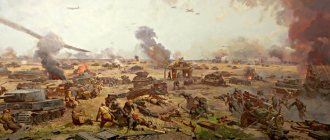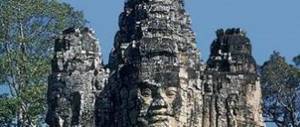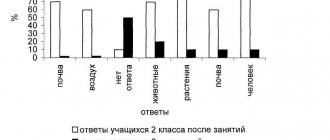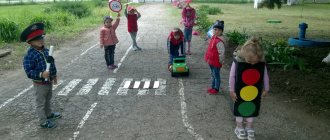Educational project on the history of the ancient world, grade 5: Great inventions of the Ancient East
Creative title: “Inventions that have passed through the centuries.”
Project abstract: The main part of this study is devoted to the history of inventions of the inhabitants of the Ancient East - Egypt, China and India. During the implementation of the project, schoolchildren study the history of the Ancient East, analyze changes in the life of ancient people based on knowledge about the development of their culture. The nature of student work involves researching literature, selecting illustrative material, and its design. The project is based on the “Chronicle of Life” technology and is implemented as part of the curriculum. The class is divided into 3 groups, each of which receives a task. The psychological characteristics of fifth-graders are taken into account, and elements of gaming and health-saving technologies are used. As a result of working on the project, students master general educational knowledge and communication skills.;
Fundamental question: “What inventions of the inhabitants of the Ancient East do we know?”
Question of the educational topic: “Repeating and generalizing lesson “Ancient East”
Project implementation time: 2 academic hours
Didactic goals of the project:
1. Educational: expansion and deepening of knowledge in the field of social and cultural history, their updating and systematization.
2. Educational: fostering a respectful and careful attitude towards historical and cultural heritage.
3. Developmental: developing interest in history as a science; skills in analyzing literature, Internet sources
Methodological tasks:
1. Cognitive: to intensify the cognitive activity of students; teach to analyze, compare, generalize, draw conclusions; introduce students to the life history of primitive people.
2. General educational: selection and systematization of material, its abstracting; the use of ICT in recording the results of the research; public presentation of research results
Stages of work on the project
Stage 1. Motivation of students.
Presentation of the presentation “Inventions that have passed through the centuries” (Appendix 1)
As a result, students get acquainted with the inventions of the inhabitants of the Ancient East, which are used by modern people, and also determine the goal of working on the project: to learn about the history of inventions made by the inhabitants of Egypt, China and India.
Stage 2. Group work
The class is divided into 3 groups (Egyptologists, Sinologists, Indians), each of which receives an assignment in the form of route sheets. (Appendix 2) . Fifth graders distribute responsibilities and get acquainted with the material on this topic, using available sources in the lesson: the Internet, encyclopedias, educational literature.
Homework: using various sources, prepare a report in the form of a presentation, wall newspaper or skit. A diagram “How to make a presentation” is proposed (Appendix 3) .
Stage 3. Presentation of project results.
At the 2nd lesson, the guys present their reports.
Stage 4. Summarizing.
Students are asked to fill out self-assessment sheets for their work on the project (Appendix 4) . Based on their self-assessment and evaluation, teachers assign final grades.
5 ways to spice up your Ancient History lessons. Let's make it interesting for children!
Shutterstock / Monkey Business Images
The history course at school begins in fifth grade with the study of the Ancient World. If the lessons are boring, this may discourage interest in the subject for the rest of the time. Our blogger Yulia Papanova has made a selection of interesting activities that will help get your child interested in history.
Mela newsletter
We send our interesting and very useful newsletter twice a week: on Tuesday and Friday
Virtual excursions
During the pandemic, a huge number of virtual 3D excursions have appeared on the Internet - you can travel around the world without leaving your couch. And, of course, it’s interesting to visit the places you study in class. For example, in Ancient Egypt. To help the teacher prepare for the lesson, you can watch videos on YouTube where Egyptologists conduct online tours of the tombs and comment on everything there.
You can conduct such an excursion as an introduction to the topic, so that the students themselves try to draw conclusions about life in Ancient Egypt based on the drawings on the walls of the tombs: how they dressed, what they ate, what they did, what sciences they already knew (on the ceiling, for example, there was often a map depicted there starry sky), what animals were there, etc. And then this information can be compared with the text of the paragraph to check yourself.
Group work
To organize work in groups, I stole several ideas from this site. For example, the election of the head of Olympus. Children are divided into groups, each group draws out its own god/goddess and comes up with a campaign speech why this particular deity should take the place of Zeus. You are allowed not only to praise your god, but also to criticize your competitors. Elections are held secretly or by show of hands. While students are preparing, they have to carefully re-read the information about the gods of Ancient Greece and remember it better. In addition, meta-subject skills also develop.
A similar lesson can be conducted on the Roman Empire: each group receives a description of the real biography of one of the emperors of Ancient Rome and prepares election propaganda. Also, my students in groups came up with excursions around Ancient Greece, but you can choose any other country of the Ancient World. They had to present a week-long tour, having thought through which cities would be included, where tourists would spend the night, what they would travel on, what they would eat, what sights they would see, etc.
Experiments
I haven't done this, but I really like the idea. You can spend some time on the architecture of Ancient Greece and conduct an experiment showing that the Greeks knew the laws of physics quite well: it’s not for nothing that they had so many buildings with columns!
Using Artifacts
There is a very cool website “Teaching History in 100 Subjects” from the British Museum. Its magnificence is that each of the hundreds of subjects is accompanied by very detailed methodological developments that can be done in class. For example, the Standard of War and Peace from Ur is an artifact from Sumer.
The following tasks are offered:
1.
Have students look at the side that shows war. What weapons do the warriors have? How are soldiers protected? Was the Sumerian army well organized? Compare the images with other ancient warriors, such as the Egyptians.
2.
Have students make a list of objects that symbolize power and wealth. How do they differ on the two sides of the Standard (war and peace)?
3.
Suggest what the Standard could have been used for, etc.
History project 5th grade
Advanced training course for 340 rubles!
Emotional burnout of teachers. Prevention and ways to overcome
Add original materials and receive prizes from Infourok
Weekly prize fund 100,000 RUR
- Sokolova Olesya Sergeevna
- Write
- 4093
- 22.04.2018
Slide captions:
Project work on history Topic: The history of our names is rooted in the ancient world Completed by: Salobuto Nadezhda, Salobuto Ekaterina, 5th grade students Supervisor: Sokolova O.I.
Project type: informational, mono-project on the subject of history, group project Project goal: find out the history of the origin of the names of the children in our class Project product: wall newspaper “Flower of Names”
Project objectives Conduct a survey of children Study information using literature and Internet sources Design a wall newspaper “Flower of Names” Prepare a presentation and speech
Work planning: We determined the topic of the project, set the goal, the objectives of the project Interviewed the guys Read the literature Wrote a report on the work Made a product (wall newspaper)
Collection of information https://imya.com/ https://planeta-imen.narod.ru/namehistory.html https://onlineslovari.com/slovar_lichnyih_imen/ https://www.onlinedics.ru/slovar/nam.html https://litrus.net/book/read/67332 https://www.slovopedia.com/19/192-0.html Please note that all sites are DICTIONARIES of personal names containing complete, scientific information!
Questioning (10 guys) What does your name mean (translation)? Where does your name come from? 6 people - know, 1 person - knows incorrectly 3 people - don’t know 2 people - know incorrectly 8 people - don’t know
Creative task
ASSIGNMENTS FOR 5TH GRADES
Competition “Solve historical problems” “History Tape” Make calculations in writing
(1 point for the correct answer, 1 point for the solution)
1. In 1985, the remains of a burial were found that had lain in the ground for 784 years. In what year was this burial made? Answer: 1202g
2. The first mention of Moscow dates back to 1147. Calculate how old the city is this year. Answer: 872g
3. The city of Rome was founded in 753 BC. Calculate how old the city is this year. Answer: 2772g
4. The city of Moscow was founded in 1147, and the city of Rome - 753 BC. Which city was founded first? For how many years? Answer: 1900 years earlier than Rome
5. The famous uprising of Spartacus took place in Rome in 74 BC. How many years ago did the Spartacus uprising begin? Answer:2093 years ago
6. The ancient Roman writer Titus Livius was born in 59 BC and died in 17 BC. At what age did Titus Livius die? Answer:42 g
7. The famous Roman Emperor Octavian Augustus reigned from 30 BC. to 14 AD Calculate how many years Octavian Augustus ruled in Rome? Answer: 44 years old
8. The famous Babylonian king Hammurabi reigned from 1792 BC. to 1750 BC Calculate how many years did King Hammurabi reign? Answer: 42 years old.
9. The famous Pyramid of Cheops in Egypt was built in 2600 BC. How many years ago was the Cheops pyramid built? Answer: 4619l ago built
10. The war between the ancient Greek cities of Sparta and Athens began in 380 BC. and lasted 30 years. In what year did this war end? Answer: 350 BC
ASSIGNMENTS FOR 6TH GRADES
Competition “Solve historical problems” “History Tape” Make calculations in writing
(1 point for the correct answer, 1 point for the solution)
1.The blacksmith forged the sword in 1959 BC. How many years ago did this happen? Make your calculations in writing. Answer: 3978g
2. The famous Battle of Marathon took place in 490 BC. Calculate how many years ago this battle took place. Answer:2509
3. Which event happened earlier - the Battle of Kulikovo (1380) or the founding of St. Petersburg (1703)? How much earlier? Answer: 323 years earlier Kulikovskaya
4. Gaius Julius Caesar died in 44 BC. at the age of 56 years. In which year he was born? Answer: 100 BC
5. In 221 BC. The ruler of the Qin kingdom united the disparate states of China under his rule. This state lasted only 14 years and collapsed 3 years after the death of the ruler. In what year did the ruler die? Answer:221-14=207+3=210 BC
6. In 1900, archaeologists excavated the leader’s burial ground, where the remains of beads made of precious stones, gold and silver vessels were found. It was established that the burial was made 7240 years ago. In what year was the leader buried? Answer: 5340 BC
7. According to legend, the first Olympic Games were organized by Hercules in 776 BC, and in 394. Emperor Theodosius I banned them as pagan. How many years did the tradition of holding games last? Answer: 1170 BC
8. Rome was founded in 753 BC. How many years passed from the founding of Rome to 1147? , i.e. before the first mention of Moscow in chronicles? Answer: 1900.
9.In 1997 archaeologists have found the remains of an ancient settlement that was burned 5533 years ago. What year did the fire happen? Answer: 3536 BC
10. It is believed that the architect Imhoten began building the first pyramid in 2750 BC. The last pyramids were built in 1700 BC. e. How many years passed between the construction of the first and last pyramid Answer: 1050g
TASKS FOR 7th-8th grades
Competition “Solve historical problems” “History Tape” Make calculations in writing
(1 point for the correct answer, 1 point for the solution)
1.
The Great Patriotic War began in 1945.
The Battle of Kulikovo took place in 1380. Which event happened earlier and by how much? Answer: - 323 years earlier Kulikovskaya
2. Moscow was founded in 1147. Our school opened in 1985. Which event happened earlier and by how much?
3. In 988, the baptism of Rus' took place. In 1276, the Moscow principality was formed. Which event happened earlier and by how much?
4. In 1564, Ivan Fedorov published the first book in Moscow. In 1812, Russia fought the Patriotic War with France. Which event happened earlier and by how much?
5. In 1905, a revolution began in Russia. In 1019, Prince Yaroslav the Wise reigned in Kyiv. Which event happened earlier and by how much?
6. In 3000 BC. e. a unified state was formed in Egypt. In 221 BC. e. a unified state was formed in China. Which event happened earlier and by how much?
7. In 1200 BC. e. The Trojan War occurred. In 74 BC. e. A slave uprising led by Spartacus began in Rome. Which event happened earlier and by how much?
8. In 334 BC. e. The Eastern campaign of Alexander the Great began. In 1750 BC. e. There was a popular uprising in Egypt. Which event happened earlier and by how much?
9. In 525 BC. e. the Persians attacked Egypt. In 753 BC. e. the city of Rome was founded. Which event happened earlier and by how much?
10. In 48 BC. e. Gaius Julius Caesar became the ruler of Rome. In 490 BC. e. The Battle of Marathon took place. Which event happened earlier and by how much?
ASSIGNMENTS FOR 9TH GRADES
Competition “Solve historical problems” “History Tape” Make calculations in writing
(1 point for the correct answer, 1 point for the solution)
1. In 1985, the remains of a burial were found that had lain in the ground for 784 years. In what year was this burial made?
2. The first mention of Moscow dates back to 1147. Calculate how old the city is this year.
3. The city of Rome was founded in 753 BC. Calculate how old the city is this year.
4.The blacksmith forged the sword in 1959 BC. How many years ago did this happen? Make your calculations in writing.
5. The famous Battle of Marathon took place in 490 BC. Calculate how many years ago this battle took place.
6. Which event happened earlier - the Battle of Kulikovo (1380) or the founding of St. Petersburg (1703)? How much earlier?
7. Gaius Julius Caesar died in 44 BC. at the age of 56 years. In which year he was born?
8. In 334 BC. e. The Eastern campaign of Alexander the Great began. In 1750 BC. e. There was a popular uprising in Egypt. Which event happened earlier and by how much?
9. In 525 BC. e. the Persians attacked Egypt. In 753 BC. e. the city of Rome was founded. Which event happened earlier and by how much?
10. In 48 BC. e. Gaius Julius Caesar became the ruler of Rome. In 490 BC. e. The Battle of Marathon took place. Which event happened earlier and by how much?
TASKS FOR 10-11 X grades
Competition “Solve historical problems” “History Tape” Make calculations in writing
(1 point for the correct answer, 1 point for the solution)
1. The famous Roman emperor Octavian Augustus reigned from 30 BC. to 14 AD Calculate how many years Octavian Augustus ruled in Rome?
2. The famous Babylonian king Hammurabi reigned from 1792 BC. to 1750 BC Calculate how many years did King Hammurabi reign?
3. The famous Pyramid of Cheops in Egypt was built in 2600 BC. How many years ago was the Cheops pyramid built?
4. The war between the ancient Greek cities of Sparta and Athens began in 380 BC. and lasted 30 years. In what year did this war end?
5. According to legend, the first Olympic Games were organized by Hercules in 776 BC, and in 394. Emperor Theodosius I banned them as pagan. How many years did the tradition of holding games last?
6. Rome was founded in 753 BC. How many years passed from the founding of Rome to 1147? , i.e. before the first mention of Moscow in chronicles?
7.In 1997 archaeologists have found the remains of an ancient settlement that was burned 5533 years ago. What year did the fire happen?
8. It is believed that the architect Imhoten began building the first pyramid in 2750 BC. The last pyramids were built in 1700 BC. e. How many years passed between the construction of the first and last pyramid?
9. In 525 BC. e. the Persians attacked Egypt. In 753 BC. e. the city of Rome was founded. Which event happened earlier and by how much?
10. In 48 BC. e. Gaius Julius Caesar became the ruler of Rome. In 490 BC. e. The Battle of Marathon took place. Which event happened earlier and by how much?




